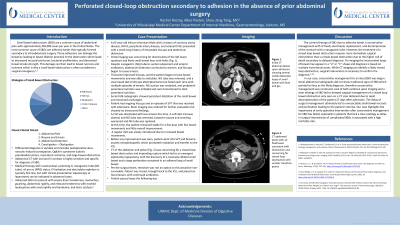Sunday Poster Session
Category: Small Intestine
P1547 - Perforated Closed Loop Obstruction Secondary to Adhesion in the Absence of Prior Abdominal surgery
Sunday, October 27, 2024
3:30 PM - 7:00 PM ET
Location: Exhibit Hall E

Has Audio

Rachel Rocray, BS
University of Mississippi Medical Center
Madison, MS
Presenting Author(s)
Rachel Rocray, BS1, Allee Paxton, 2, Shou-jiang Tang, MD2
1University of Mississippi Medical Center, Madison, MS; 2University of Mississippi Medical Center, Jackson, MS
Introduction: Closed-loop bowel obstructions are a type of small bowel obstruction (SBO) most commonly caused by adhesive bands formed from prior abdominal surgery that require timely diagnosis as they can rapidly lead to bowel necrosis and ischemia.
Case Description/Methods: A 65 year old male with no surgical history presented with a one-week history of hiccups and abdominal distension. Imaging was concerning for diverticulitis and likely small bowel ileus. Despite nasogastric (NG) tube to suction placement and empiric antibiotics, abdominal distension worsened and hiccups began to cause emesis. Thorazine improved the hiccups, and the patient began to have bowel movements. The NG tube was removed and a clear liquid diet was tried twice but failed due to emesis. NG suction was restarted and peripheral parenteral nutrition was initiated and soon transitioned to total parenteral nutrition. Serial abdominal radiographs showed persistent dilatation of the small bowel. Subcutaneous neostigmine was given in an effort to resolve the ileus but was stopped due to wheezing. The patient had an episode of supraventricular tachycardia (SVT) resolved with adenosine. Brain imaging was ordered for evaluation and showed no intracranial findings. A clear liquid diet was attempted with less emesis this try. A soft diet was started and the NG tube was removed, however emesis worsened and the NG tube was replaced. At this time the patient remained stable for days with few bowel movements and no improvement. A regular diet was slowly introduced due to increased bowel movements, but before improvement was seen, the patient went into SVT and became acutely encephalopathic which prompted intubation and transfer to the ICU. A CT abdomen/pelvis showed likely closed loop obstruction which led to an emergent exploratory laparotomy with the discovery of a massively dilated small bowel and a large perforation contained in an adhered loop of small bowel. Per the surgical team, resection was not an option as it would be unsurvivable. The patient was closed, returned to the ICU, and died the next day.
Discussion: The current therapy of SBO is conservative management. In our case, lack of evidence upon imaging and a clear etiology of SBO led to delayed surgical management of a closed-loop bowel obstruction only seen on a CT scan obtained 27 days after admission. Early operative intervention is crucial in patients who lack a clear etiology as delay in surgical intervention of complicated SBOs is associated with a higher mortality rate.
Disclosures:
Rachel Rocray, BS1, Allee Paxton, 2, Shou-jiang Tang, MD2. P1547 - Perforated Closed Loop Obstruction Secondary to Adhesion in the Absence of Prior Abdominal surgery, ACG 2024 Annual Scientific Meeting Abstracts. Philadelphia, PA: American College of Gastroenterology.
1University of Mississippi Medical Center, Madison, MS; 2University of Mississippi Medical Center, Jackson, MS
Introduction: Closed-loop bowel obstructions are a type of small bowel obstruction (SBO) most commonly caused by adhesive bands formed from prior abdominal surgery that require timely diagnosis as they can rapidly lead to bowel necrosis and ischemia.
Case Description/Methods: A 65 year old male with no surgical history presented with a one-week history of hiccups and abdominal distension. Imaging was concerning for diverticulitis and likely small bowel ileus. Despite nasogastric (NG) tube to suction placement and empiric antibiotics, abdominal distension worsened and hiccups began to cause emesis. Thorazine improved the hiccups, and the patient began to have bowel movements. The NG tube was removed and a clear liquid diet was tried twice but failed due to emesis. NG suction was restarted and peripheral parenteral nutrition was initiated and soon transitioned to total parenteral nutrition. Serial abdominal radiographs showed persistent dilatation of the small bowel. Subcutaneous neostigmine was given in an effort to resolve the ileus but was stopped due to wheezing. The patient had an episode of supraventricular tachycardia (SVT) resolved with adenosine. Brain imaging was ordered for evaluation and showed no intracranial findings. A clear liquid diet was attempted with less emesis this try. A soft diet was started and the NG tube was removed, however emesis worsened and the NG tube was replaced. At this time the patient remained stable for days with few bowel movements and no improvement. A regular diet was slowly introduced due to increased bowel movements, but before improvement was seen, the patient went into SVT and became acutely encephalopathic which prompted intubation and transfer to the ICU. A CT abdomen/pelvis showed likely closed loop obstruction which led to an emergent exploratory laparotomy with the discovery of a massively dilated small bowel and a large perforation contained in an adhered loop of small bowel. Per the surgical team, resection was not an option as it would be unsurvivable. The patient was closed, returned to the ICU, and died the next day.
Discussion: The current therapy of SBO is conservative management. In our case, lack of evidence upon imaging and a clear etiology of SBO led to delayed surgical management of a closed-loop bowel obstruction only seen on a CT scan obtained 27 days after admission. Early operative intervention is crucial in patients who lack a clear etiology as delay in surgical intervention of complicated SBOs is associated with a higher mortality rate.
Disclosures:
Rachel Rocray indicated no relevant financial relationships.
Allee Paxton indicated no relevant financial relationships.
Shou-jiang Tang indicated no relevant financial relationships.
Rachel Rocray, BS1, Allee Paxton, 2, Shou-jiang Tang, MD2. P1547 - Perforated Closed Loop Obstruction Secondary to Adhesion in the Absence of Prior Abdominal surgery, ACG 2024 Annual Scientific Meeting Abstracts. Philadelphia, PA: American College of Gastroenterology.

